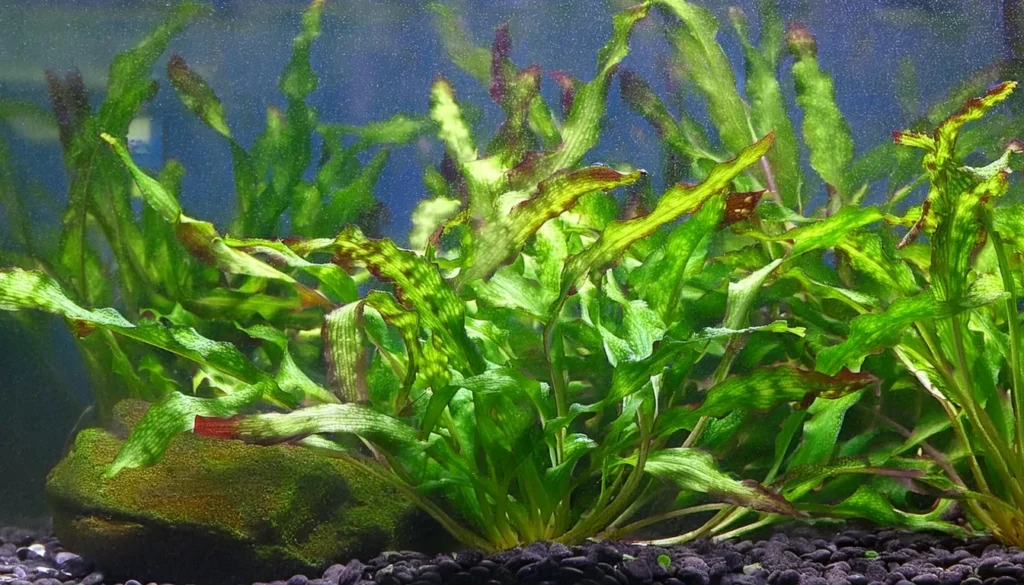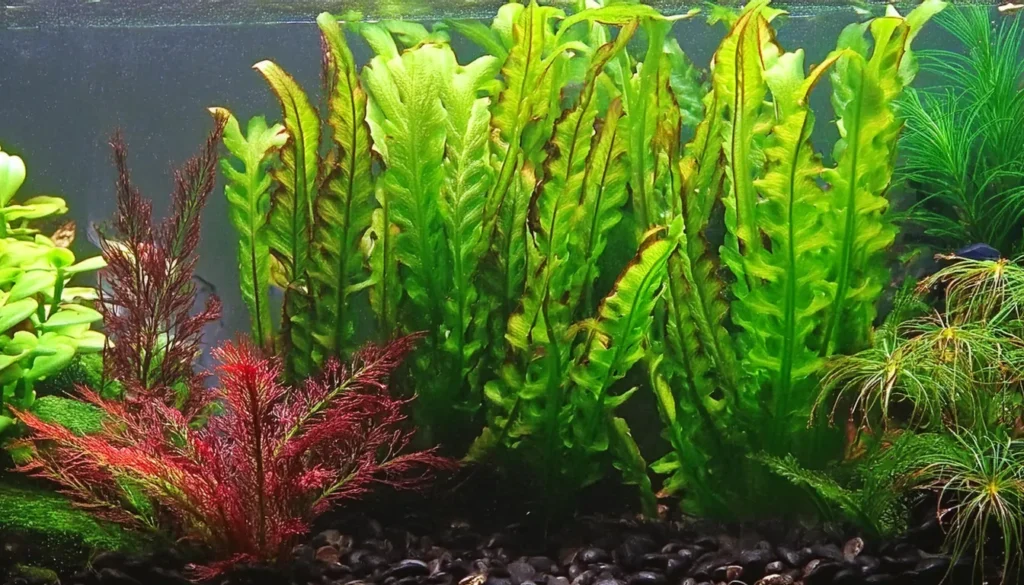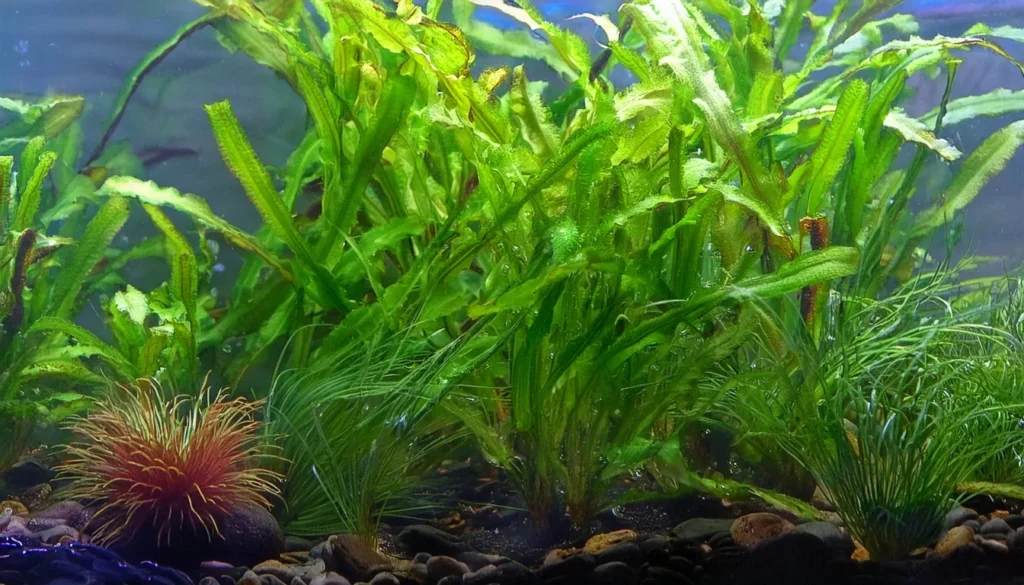Welcome to our comprehensive guide on Helanthium Vesuvius, also known as Echinodorus Vesuvius.
This visually stunning aquatic plant is a true marvel in any aquarium setup.
With its spiral-shaped leaves and vibrant green color, Helanthium Vesuvius adds elegance and charm to your underwater oasis.
In this article, we will delve into the unique aesthetics of Helanthium Vesuvius and uncover the secrets to caring for and propagating this captivating plant.
From understanding its growth patterns to designing striking aquascapes, we’ll equip you with the knowledge you need to unlock the full potential of Helanthium Vesuvius in your aquarium.
Key Takeaway
- Helanthium Vesuvius, also known as Echinodorus Vesuvius, is a visually striking aquarium plant with spiral-shaped leaves..
- Proper lighting, neutral pH, and root tab fertilizers are essential for Helanthium Vesuvius’ optimal growth.
- Carefully cultivating and positioning Helanthium Vesuvius can create stunning aquascapes with contrasting textures and colors.
- Understanding the propagation and growth patterns of Helanthium Vesuvius enables you to create a thriving plant population.
- Aside from its aesthetic appeal, Helanthium Vesuvius provides environmental benefits by enhancing biodiversity and contributing to water quality.
Quick Stats
| Attribute | Details |
| Family Name | Alismataceae |
| Origin | Cultivar, derived from Helanthium angustifolius |
| Height | 10-20 cm (4-8 inches) |
| pH Range | 6.0 – 7.5 |
| CO2 Requirement | Moderate |
| Growth Rate | Moderate |
| Care Level | Moderate |
| Color Form | Bright Green |
| Water Conditions | 22-28°C (72-82°F), adaptable to a range of hardness |
| Max Size | Leaves can grow up to 20 cm (8 inches) in length |
| Lighting | Moderate to High |
| Supplements | CO2 supplementation and comprehensive liquid fertilizer |
| Placement | Foreground to Mid-ground |
| Propagation | Runners |

What Is Helanthium Vesuvius (Echinodorus)?
Welcome to the world of Helanthium Vesuvius, a captivating aquatic marvel that has taken the aquarium community by storm.
Also known as Echinodorus Vesuvius, this plant stands out with its unique spiral aesthetics and vibrant green color.
Let’s embark on a journey to unravel the secrets of this extraordinary plant.
Natural Habitat And Origin
Helanthium vesuvius is a relatively new cultivar, and information about its specific natural habitat and origin may be limited.
However, it is a member of the Helanthium genus, which is native to the Americas, particularly North and Central America.
The exact origins of Helanthium vesuvius as a cultivated aquarium plant are not well-documented, but it is likely that it was selectively bred from other Helanthium species to exhibit its unique characteristics.
Physical Characteristics
- Leaf Shape: The leaves of Helanthium vesuvius are narrow and elongated, often with a slight twist or curl along the edges. This gives the plant a unique and visually striking appearance compared to other sword plants.
- Leaf Color: The leaves of Helanthium vesuvius typically range from green to reddish-brown, depending on the aquarium conditions such as lighting and nutrient availability. The coloration adds depth and contrast to the aquarium landscape.
- Size: Helanthium vesuvius grows to a moderate height, typically reaching around 15-30 centimeters (6-12 inches) tall in aquariums. This makes it suitable for midground to background planting depending on the tank size and layout.
- Growth Form: Helanthium vesuvius forms dense clusters of leaves that emerge from a central crown or rosette. As the plant grows, it may produce runners that spread horizontally along the substrate, allowing for natural propagation and expansion.
The Importance Of Lighting And Intensity
- Proper lighting is crucial for the optimal growth of Helanthium Vesuvius. This plant requires moderate to high lighting levels to thrive. Placing the plant in an aquarium area that receives direct or indirect light is ideal.
- LED lights designed for aquariums can also provide the necessary brightness and intensity. Regularly monitor the lighting levels to ensure they suit the plant’s needs, as inadequate lighting can lead to stunted growth or poor health.

Water Parameters
- Temperature: Maintain the water temperature between 22°C to 28°C (72°F to 82°F). This range is typical for tropical aquarium plants and supports healthy growth for Helanthium vesuvius.
- pH: Aim for a pH range between 6.5 to 7.5. Helanthium vesuvius can tolerate a slightly acidic to neutral pH level, but avoid extreme fluctuations to prevent stress on the plant.
- Water Hardness: Helanthium vesuvius generally prefers moderately hard to soft water with a hardness range of 3 to 10 dGH (degrees of General Hardness).
- Lighting: Provide moderate to high-intensity lighting for approximately 8 to 10 hours per day. Adequate lighting is essential for photosynthesis, but be cautious of excessive light that may lead to algae growth.
- CO2: While not always necessary, supplementing carbon dioxide (CO2) can enhance growth and coloration in Helanthium vesuvius. If using CO2 injection, aim for levels of around 20 to 30 ppm (parts per million).
Optimal Temperature For Growth
The optimal temperature for the growth of Helanthium vesuvius, commonly known as Vesuvius sword or twisted sword, falls within the range of 22°C to 28°C (72°F to 82°F).
Within this temperature range, Helanthium vesuvius will exhibit healthy growth and vibrant coloration.
It’s essential to maintain stable temperatures within this range to avoid stressing the plant, as fluctuations outside this range may impede growth and overall health.
Choosing The Right Substrate
- A suitable substrate is crucial for the successful cultivation of Helanthium Vesuvius. Opt for a nutrient-rich substrate that provides essential elements for the plant’s growth and development.
- Consider using a specialized aquarium plant substrate or a blend of nutrient-rich soil and gravel to create an ideal Vesuvius Sword Aquarium Plant foundation.

Arranging The Plants
- When arranging Helanthium Vesuvius in your aquarium, consider grouping them to accentuate their visual impact. Place the plants closer to the foreground or midground of the tank to ensure they remain the focal point of your aquascape.
- Experiment with different arrangements and spacing to find a layout that best highlights the spiral texture and vibrant colors of the Helanthium Vesuvius leaves.
- Some aquarists prefer to alternate the plants with other species to create an aesthetically pleasing contrast, while others create a dense cluster of Vesuvius plants for a more dramatic effect.
Recommended Tank Size
- For a single specimen or small group: A tank size of at least 10 gallons (38 liters) would be suitable for accommodating a single specimen or a small group of Helanthium vesuvius plants.
- For larger groupings or extensive planting: A tank size of 20 gallons (75 liters) or larger would be more appropriate for creating larger groupings or extensive planting of Helanthium vesuvius. This allows ample space for the plants to spread and grow, creating a visually striking display.
Suitable Tank Mates
- Small to Medium-sized Fish: Species such as tetras, rasboras, danios, gouramis, and smaller cichlids like Apistogramma can peacefully cohabit with Helanthium vesuvius. Avoid larger or aggressive fish species that may uproot or damage the plants.
- Bottom-dwelling Fish: Corydoras catfish and small loaches are excellent choices as they inhabit the lower levels of the aquarium and do not typically disturb the plants.
- Shrimp and Snails: Peaceful invertebrates like cherry shrimp, amano shrimp, and nerite snails can help keep the aquarium clean by consuming algae and detritus. They are unlikely to bother Helanthium vesuvius.
- Dwarf Crayfish: Some species of dwarf crayfish, such as Cambarellus and CPO crayfish, can coexist with Helanthium vesuvius if provided with adequate hiding places and not overly aggressive.

Nutritional Needs Of The Plant
- Macronutrients: Helanthium vesuvius requires essential macronutrients, including nitrogen (N), phosphorus (P), and potassium (K), for robust growth. These macronutrients are vital for various metabolic processes, including photosynthesis and cell growth.
- Micronutrients: In addition to macronutrients, Helanthium vesuvius relies on micronutrients such as iron (Fe), manganese (Mn), zinc (Zn), and others. Micronutrients play crucial roles in enzyme function, chlorophyll synthesis, and overall plant health.
- Carbon (CO2): Carbon dioxide (CO2) is a vital component of photosynthesis, the process by which plants convert light energy into chemical energy. Helanthium vesuvius can benefit from supplemental CO2 in planted aquarium setups, especially in higher light conditions.
Helanthium Vesuvius Cultivation Tips
- Lighting: Provide moderate to high-intensity lighting for approximately 8 to 10 hours per day. Helanthium vesuvius requires sufficient light to carry out photosynthesis effectively. LED or fluorescent lighting fixtures designed for planted aquariums are suitable options.
- CO2 Injection: While not always necessary, supplementing carbon dioxide (CO2) can enhance growth and promote vibrant coloration in Helanthium vesuvius. Consider using a CO2 injection system to provide adequate carbon dioxide levels for optimal photosynthesis.
- Nutrient Supplementation: Ensure that the aquarium water is rich in essential nutrients, including nitrogen (N), phosphorus (P), potassium (K), and micronutrients. Regularly dose liquid fertilizers or use root tabs to provide nutrients to the substrate. Monitor nutrient levels and adjust fertilization as needed based on plant growth and water parameters.
- Substrate: Helanthium vesuvius benefits from a nutrient-rich substrate with fine grains to anchor its delicate roots. Choose substrates specifically designed for planted aquariums, such as nutrient-rich aquasoils or fine gravel mixed with laterite. A depth of at least 2-3 inches (5-8 cm) is recommended to allow for proper root penetration and stability.
Plant Propagation Tips
- Runners: this plant naturally produces runners, which are horizontal stems that grow along the substrate. These runners develop new plantlets at nodes along their length. Allow the runners to grow and develop plantlets until they have formed roots of their own. Once the plantlets have established roots, they can be carefully separated from the parent plant and replanted elsewhere in the aquarium.
- Division: If this plant has formed dense clumps, you can divide it into smaller portions. Carefully separate the clumps into individual sections, ensuring that each section has both roots and leaves. Replant these sections in the substrate, spacing them appropriately to allow for growth.
- Trimming and Planting Clippings: Use sharp scissors or aquascaping tools to trim the tops of the Helanthium vesuvius. These clippings can be replanted directly into the substrate, where they will take root and grow into new plants. Ensure that each clipping has some roots attached for successful propagation.
- Encouraging Growth: To encourage propagation, provide optimal growing conditions, including adequate lighting, nutrient supplementation, and CO2 (if applicable). Regularly monitor the plant for new growth and adjust care as needed to promote healthy propagation.

Benefits Of Planting Helanthium Vesuvius
- Aesthetic Appeal: Helanthium vesuvius features unique twisted leaves that add visual interest and texture to the aquarium. Its vibrant green coloration contrasts well with other plants and enhances the overall aesthetics of the aquascape.
- Natural Carpet Effect: When planted densely, Helanthium vesuvius forms a dense carpet-like growth, creating a lush and naturalistic look in the foreground or midground of the aquarium. This carpet effect mimics the appearance of a grassy meadow and provides a beautiful backdrop for other aquatic plants and fish.
- Oxygenation and Water Filtration: Like all aquatic plants, Helanthium vesuvius contributes to oxygenation by photosynthesizing and releasing oxygen into the water. Additionally, its root system helps to aerate the substrate and provides habitat for beneficial bacteria, contributing to overall water quality and filtration.
- Algae Prevention: By outcompeting algae for nutrients and light, Helanthium vesuvius helps to prevent the growth of unsightly algae in the aquarium. Its dense growth habit shades the substrate, reducing the availability of light for algae to thrive.

RELATED: Creating A Stunning Red Accent With Ammania Senegalensis At Home
Identifying And Managing Pests And Diseases
- Another challenge in maintaining this plant is dealing with pests and diseases that may affect its growth and vitality. Common pests that may infest this plant include snails, aphids, and algae. These pests can cause significant damage and hinder the plant’s growth if left untreated.
- To tackle these issues, it is important to regularly inspect the plant and take appropriate measures for pest control. Manual removal of pests, such as snails, can be done by handpicking or using traps. For aphids or other insect pests, introducing natural predators like ladybugs or predatory mites can help control their population.
- In cases of severe infestations, the use of organic or chemical treatments may be necessary. However, it is crucial to research and choose treatments that are safe for both the plant and the aquarium inhabitants.

Conclusion
This plant is a captivating and versatile aquarium plant with aesthetic appeal and environmental benefits.
The unique spiral-shaped leaves and vibrant green color of the vesuvius sword plant make it a visually striking addition to any aquatic setup.
Its presence adds a touch of elegance and creates a captivating focal point in the tank.
By following the guidelines and tips provided in this guide, aquarists can ensure the proper care and maintenance of Helanthium Vesuvius.
These practices contribute to the plant’s overall health and growth, from providing adequate lighting and maintaining a neutral pH to using root tab fertilizers for nourishment.
Additionally, understanding the propagation and growth patterns of Helanthium Vesuvius enables aquarists to expand their collection and create a thriving plant population.
Designing aquascapes with Vesuvius Sword Plants allows for exploring contrasting textures and colors, resulting in visually appealing and harmonious aquarium layouts.
The positioning of this plant, in conjunction with other aquatic elements, contributes to the overall balance and aesthetics of the aquascape.
Furthermore, the environmental benefits of Vesuvius Echinodorus cannot be understated.
It enhances biodiversity by providing habitats and shelter for aquatic organisms while contributing to water quality and habitat structure, maintaining a healthy aquatic environment.
Frequently Asked Questions
How Can I Design Aquascapes With Vesuvius Sword Plants?
When designing aquascapes with Vesuvius Sword Plants, consider using contrasting textures and colors to create visually appealing combinations.
Incorporate different types of plants and arrange them in a way that complements the unique spiral aesthetics of Helanthium Vesuvius.
Position the plants strategically to achieve balance and harmony in the overall aquascape.
What Care Guide Should I Follow For Helanthium Vesuvius?
To ensure the proper care of Helanthium Vesuvius, navigate the transition from emersed to submersed growth gradually.
Provide the necessary conditions for a smooth transition, including suitable lighting, stable pH, and nutrient-rich substrate.
Maintain a healthy root system using root tab fertilizers and appropriately watering the plant.
What Are The Common Challenges In Maintaining Helanthium Vesuvius In The Aquarium?
Common challenges in maintaining this plant include addressing concerns related to aquatic plant care, such as algae growth, nutrient deficiencies, and fluctuations in water parameters.
Troubleshooting these issues promptly and providing proper care will help ensure the plant’s health and well-being.
How Do I Identify And Manage Pests And Diseases That May Affect Helanthium Vesuvius?
To identify and manage pests and diseases that may affect this plant, regularly inspect the plant for signs of infestation or illness.
Early detection is crucial for effective management.
Implement preventive measures such as quarantine and maintaining proper hygiene in the aquarium.
Treatments may include targeted pest control methods or utilizing appropriate medications for diseases.
What Are The Aesthetic And Environmental Benefits Of Vesuvius Echinodorus?
Vesuvius Echinodorus enhances biodiversity in aquariums by providing habitats and shelter for aquatic organisms.
Its unique spiral aesthetics contribute to the visual appeal and diversity of aquascapes.
Furthermore, the plant’s presence helps maintain water quality and habitat structure, supporting a balanced ecosystem and promoting a healthy aquatic environment.
- Unveiling The Wonders Of Riccia Fluitans In Aquascapes - August 7, 2024
- Vallisneria Gigantea Var. Guide To Care And Cultivation At Home - July 31, 2024
- Vesicularia Dubyana Care & Growth Guide Tips For Beginner Gardeners - July 30, 2024
